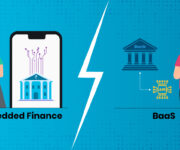Embedded Finance is not the new buzzword anymore. Instead, it is the ‘new normal’ for any brand that believes in delivering an integrated customer experience ecosystem and diversify its service offerings.
What’s impressive about embedded finance is its immense applicability across industries and sectors and how rapidly it is being adopted. For example, a study conducted in 2021 revealed that the value of the embedded finance market will exceed $138 billion by 2026.
Here is a rundown of some of the trends that explain its benefits and why it’s time to jump onto the bandwagon of embedded finance today!
Why is Embedded Finance the Future?
Industry players heavily invest in retooling their payment systems to fit client preferences and sector-specific business requirements better.
Embedded finance is not just limited to finances but also includes opportunities in insurance, lending, investments, banking, etc. Moreover, it helps create a seamless experience for all the parties involved i.e., companies, fintech, and the customers.
Also read: Ten Ways Embedded Finance Is Reshaping Customer Experience
Apple Pay, Google Pay, and QR codes are just a few wildly popular examples of new-age, tap-to-pay systems based on the tech. There are numerous others. Embedded finance is the future partly because cash is further displaced as eCommerce accounts for a larger share of spending — a long-standing trend that the pandemic has amplified. And it promises newer revenue models.
But this is not it. Here are other factors driving the growth and adoption of embedded finance. Let’s have a look at them here:
1. Changed Consumer Preferences
There is a change in behaviour and preferences of consumers shopping today, unlike a few years ago. As a result, there is more inclination towards online and non-traditional shopping platforms and social media.
With the help of embedded finance, merchants have an opportunity to offer a frictionless payment experience and ease the shift towards digitised ways of doing business.
2. Banking Disruptors
Banking disruptors and neobanks are increasingly gaining popularity, as more and more people today turn towards their mobile app for completing any financial transaction; be it shopping online for clothes or ordering food, paying for bills or investing in mutual funds. All of these are classic cases of embedded finance being put to play, and time and again, in the real world.
3. Open Mindset
People seem to be more open-minded towards sharing their personal information such as banking details and other financial data with third-party apps.
All people are looking for are ways to simplify their experience with the brands. However, in wanting so, they’re willing to share information to a considerable extent, even amidst security concerns.
Also read: Rising Concerns Around Data Privacy with Growth of Digital Lending
Secure and high-tech embedded finance solutions — like the recent introduction of Account Aggregators by India — are therefore gaining popularity.
Why is it Time to Jump onto The Bandwagon of Embedded Finance?
As businesses rethink value chains to streamline operations in a post-pandemic world, increase revenue, and cut expenses, embedded finance promises to help with all three concerns. This development alone is enough reason for every business to embrace embedded finance as part of their solution and future strategy.
Here is a list of other reasons in favour of embedded finance and why it is the future of banking, finance, and almost every business:
1. It Helps Cater to the New-Age Pain-Points
Embedded finance possesses the power to solve genuine pain points of businesses and their customers. Not only this, it has added tremendous value worldwide by helping the unbanked population to receive instant payments, all without resorting to any paperwork or standing in long queues.
For instance, ride-hailing giant Uber ensured all its drivers received timely and consistent payments by simply entering into a partnership with a debit card company under which all the drivers had access to pre-paid cards.
Also read: Can Fintech Innovations Bridge India’s Financial Inclusion Divide?
Another example is the embedded finance platform called ‘Stripe’ with the help of which e-commerce websites such as Amazon can provide instant credit (Just-In-Time-Lending) to their customers, resulting in increased customer engagement and purchases.
2. It Helps Predict Customer Needs
Embedded finance coupled with Artificial Intelligence (AI) and other techs can predict the needs and intent of customers based on their past behaviours and patterns, which will help businesses bridge gaps or meet areas of improvement.
For example, tech-savvy fintech companies can easily explore areas of opportunity or analyze customer patterns to arrive at the products in demand in the future.
3. It Helps Businesses Upsell
When banking services were not digitised, customers were required to visit the banks in person to fulfil their banking needs. This provided banks with an opportunity to upsell other bank-related products and services such as loans or Fixed Deposits(FDs), etcetera.
However, with increased digitisation, banks started losing out on this customer stickiness as customers simply switched to online banking channels.
This shift towards online channels also jeopardised the banks’ stronghold over the customers and went to new and upcoming fintech platforms. With complete access to the financial and other information of customers, along with their bank account and credit history, fintech platforms have a better chance to upsell other appropriate financial products to these customers and expand their revenue streams accordingly.
4. It Helps Provide a Holistic View into Finances
Embedded finance will look at different problems faced by businesses and customers with a holistic viewpoint and help solve them contextually.
For example, people will be able to turn to embedded finance for making their financial decisions. Moreover, it will inform people of the repercussions of their financial decisions by giving them a good look into the consequences of different choices they can make.
Say, an embedded credit card guiding people to use or avoid using their credit cards for making specific purchases based on their credit history and overall debt levels. This system will prove a turning point in the financial ecosystem that will help people improve their credit scores.
Also read: Digital Lending: Perks of Going Paperless
Embedded finance, in simple words, is set to disrupt lending, as you know it, and will reign the world of fintech in the decades to come. Finezza’s Loan Origination, Loan Management, Bank Statement Analysis, and other offerings sync with the new age lending.
Banks, NBFCs, and other lenders can achieve the critical tasks of tracking, managing credit applications, processing KYC documents faster, and assess lending risks and streamline the entire lending process more efficiently. For more information contact us today.




Leave a Reply